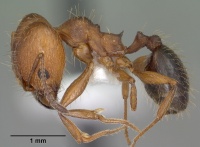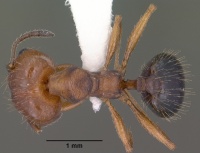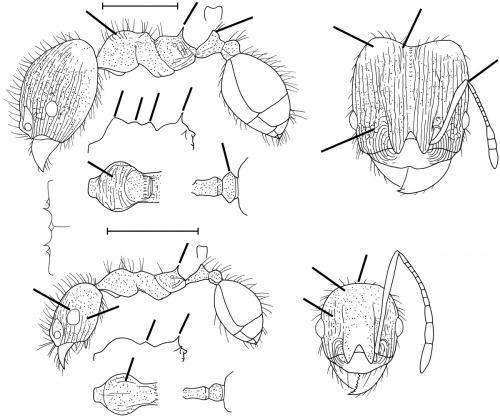Pheidole sciara
| Pheidole sciara | |
|---|---|

| |
| Scientific classification | |
| Kingdom: | Animalia |
| Phylum: | Arthropoda |
| Class: | Insecta |
| Order: | Hymenoptera |
| Family: | Formicidae |
| Subfamily: | Myrmicinae |
| Tribe: | Attini |
| Genus: | Pheidole |
| Species: | P. sciara |
| Binomial name | |
| Pheidole sciara Cole, 1955 | |
A colony found in Hidalgo County, New Mexico, by Stefan Cover (unpublished field notes) was in open desert with scattered mesquite, yucca, and Ephedra, occupying a soil nest with an entrance in a grass clump. A second colony was discovered by Cover nesting in open soil near Pecos, Texas, in saline desert among growth of Limonium and Salicornia. Nests reported by Moody and Francke (1982) in western Texas were at 600 to 1700 m and variously under stones and in open soil. (Wilson 2003)
Identification
The major of this species can be recognized by the flattened area at the base of the scape, the long scape, the rough sculpture over the entire dorsal surface of the head, and the coarse, transverse pronotal rugae, with the intrarugal spaces shining. The petiolar notch is shallow, but broad, the hairs on the gaster are long, nearly of equal length, blunt, and widely spaced. The head of the minor is smooth and shining, the postpetiole is globular and less than twice the width of the node of the petiole. (Mackay and Mackay 2002)
See the description in the nomenclature section.
Keys including this Species
Distribution
West-central Texas to southwestern New Mexico. (Wilson 2003)
Latitudinal Distribution Pattern
Latitudinal Range: 35.715298° to 29.5639°.
| North Temperate |
North Subtropical |
Tropical | South Subtropical |
South Temperate |
- Source: AntMaps
Distribution based on Regional Taxon Lists
Nearctic Region: United States (type locality).
Neotropical Region: Mexico.
Distribution based on AntMaps
Distribution based on AntWeb specimens
Check data from AntWeb
Countries Occupied
| Number of countries occupied by this species based on AntWiki Regional Taxon Lists. In general, fewer countries occupied indicates a narrower range, while more countries indicates a more widespread species. |

|
Estimated Abundance
| Relative abundance based on number of AntMaps records per species (this species within the purple bar). Fewer records (to the left) indicates a less abundant/encountered species while more records (to the right) indicates more abundant/encountered species. |

|
Habitat
Open, sandy, semi-desert areas.
Biology
This species nests in the soil, with the entrance surrounded by a small mound.
Castes
Worker
Images from AntWeb
  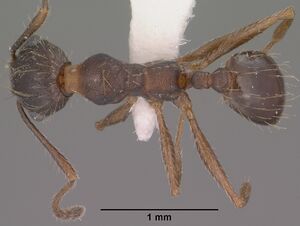 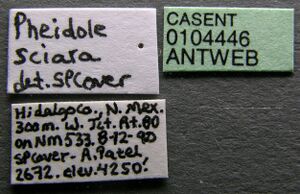
| |
| Worker. Specimen code casent0104446. Photographer Jen Fogarty, uploaded by California Academy of Sciences. | Owned by MCZ, Cambridge, MA, USA. |
Nomenclature
The following information is derived from Barry Bolton's Online Catalogue of the Ants of the World.
- sciara. Pheidole sciara Cole, 1955a: 47 (s.w.) U.S.A. See also: Wilson, 2003: 346.
Unless otherwise noted the text for the remainder of this section is reported from the publication that includes the original description.
Description
From Wilson (2003): A member of the fallax group, somewhat similar to Pheidole optiva of Mexico, distinguished as follows.
Major: in dorsal-oblique view, promesonotal dorsal profile with 3 roughly equal lobes (2 pronotal, 1 mesonotal); rugoreticulum on each side of head extends from eye to antennal fossa; central third of head dorsum, from frontal lobes to occiput, carinulate, and occipital lobes smooth; pronotal dorsum entirely carinulate; propodeal spines one third as long as and nearly vertical to basal propodeal face; postpetiole elliptical, with angulate lateral borders.
Minor: entire head, mesosoma, and waist foveolate and opaque; eyes large, Eye Length one-third Head Width.
MEASUREMENTS (mm) Paratype major: HW 1.48, HL 1.52, SL 0.86, EL 0.26, PW 0.80. Paratype minor: HW 0.62, HL 0.76, SL 0.86, EL 0.20, PW 0.40.
COLOR Major: body light reddish brown except for gaster, which is plain medium to dark brown.
Minor: body plain medium brown, appendages light to medium brown.
Figure. Upper: paratype, major. Lower: paratype, minor. Scale bars = 1 mm.
Type Material
NEW MEXICO: Lordsburg, col. Arthur C. Cole, Museum of Comparative Zoology - as reported in Wilson (2003)
Etymology
Gr sciara, shaded, possibly alluding to color of the types. (Wilson 2003)
References
- Cole, A. C., Jr. 1955a. Studies of New Mexico ants. XIV. A description of a new species of Pheidole Westwood (Hymenoptera: Formicidae). J. Tenn. Acad. Sci. 30: 47-49. (page 47, soldier, worker described)
- Mackay, W. P. and E. Mackay. 2002. The ants of New Mexico (Hymenoptera: Formicidae). Edwin Mellen Press, Lewiston, NY.
- Moody, J. V., Francke, O. F. 1982. The ants (Hymenoptera, Formicidae) of western Texas, Part 1: Subfamily Myrmicinae. Grad. Stud. Tex. Tech Univ. 27: 1–80.
- Wilson, E. O. 2003. Pheidole in the New World: A dominant, hyperdiverse ant genus. Harvard University Press, Cambridge, MA. (page 346, fig. major, minor described)
References based on Global Ant Biodiversity Informatics
- Cole A. C., Jr. 1955. Studies of New Mexico ants. XIV. A description of a new species of Pheidole Westwood (Hymenoptera: Formicidae). Journal of the Tennessee Academy of Science 30: 47-49.
- Cover S. P., and R. A. Johnson. 20011. Checklist of Arizona Ants. Downloaded on January 7th at http://www.asu.edu/clas/sirgtools/AZants-2011%20updatev2.pdf
- Johnson R. Personnal Database. Accessed on February 5th 2014 at http://www.asu.edu/clas/sirgtools/resources.htm
- Mackay W. P., and E. E. Mackay. 2002. The ants of New Mexico (Hymenoptera: Formicidae). Lewiston, New York: Edwin Mellen Press, 400 pp.
- McDonald D. L., D. R. Hoffpauir, and J. L. Cook. 2016. Survey yields seven new Texas county records and documents further spread of Red Imported Fire Ant, Solenopsis invicta Buren. Southwestern Entomologist, 41(4): 913-920.
- Moody J. V., and O. F. Francke. 1982. The Ants (Hymenoptera, Formicidae) of Western Texas Part 1: Subfamily Myrmicinae. Graduate Studies Texas Tech University 27: 80 pp.
- O'Keefe S. T., J. L. Cook, T. Dudek, D. F. Wunneburger, M. D. Guzman, R. N. Coulson, and S. B. Vinson. 2000. The Distribution of Texas Ants. The Southwestern Entomologist 22: 1-92.
- Wheeler, G.C. and J. Wheeler. 1985. A checklist of Texas ants. Prairie Naturalist 17:49-64.
- Wilson, E.O. 2003. Pheidole in the New World: A Dominant, Hyperdiverse Genus. Harvard University Press
